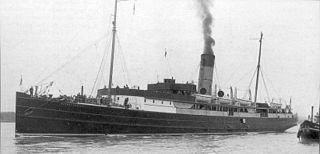Related Research Articles

The Lancashire and Yorkshire Railway (L&YR) was a major British railway company before the 1923 Grouping. It was incorporated in 1847 from an amalgamation of several existing railways. It was the third-largest railway system based in northern England.

The Illawarra Steam Navigation Company was a shipping company that serviced the south coast of New South Wales, Australia from 1858 to the early 1950s. It was formed through the amalgamation of the General Steam Navigation Company, the Kiama Steam Navigation Company and the Shoalhaven Steam Navigation Company, each of whom serviced parts of the south coast with their respective vessels. After merging, the new company held a near monopoly in regard to shipping on the south coast, and their fleet visited every significant port between Sydney and the border of Victoria. The company transported both passengers and a range of produce, including livestock, and hence it became known as the 'Pig and Whistle Line': it was said that ships would wait an hour for a pig but not a minute for a passenger.
The West Cornwall Steam Ship Company was established in 1870 to operate ferry services between Penzance, Cornwall, and the Isles of Scilly. It became the West Cornwall Steamship Company in 1907 and was wound up in 1917.

TSS Duke of Clarence was a passenger vessel operated jointly by the London and North Western Railway and the Lancashire and Yorkshire Railway (LYR) from 1892 between Fleetwood and northern Irish ports. In 1906 the LYR bought her outright and transferred her to their summer service from Hull to Zeebrugge, returning to the Irish Sea in winter. During the First World War Duke of Clarence served as an armed boarding steamer. She resumed passenger service in 1920, passing through changes of ownership in the reorganisations of Britain's railway companies in the 1920s, until she was scrapped in 1930.

The Drogheda Steam Packet Company was founded in 1826 as the Drogheda Paddle Steamship Co. It provided shipping services between Drogheda and Liverpool from 1825 to 1902, in which year it was taken over by the Lancashire and Yorkshire Railway.
PS Tredagh was a paddle steamer passenger vessel operated by the Drogheda Steam Packet Company from 1876 to 1902 and the Lancashire and Yorkshire Railway from 1902 to 1912.
PS Iverna was a paddle steamer passenger vessel operated by the Drogheda Steam Packet Company from 1895 to 1902 and the Lancashire and Yorkshire Railway from 1902 to 1912.
PS Kathleen Mavourneen was a paddle steamer passenger vessel operated by the Drogheda Steam Packet Company from 1855 to 1902 and the Lancashire and Yorkshire Railway from 1902 to 1903.
TSS Colleen Bawn was a twin screw passenger steamship operated by the Lancashire and Yorkshire Railway from 1903 to 1922.
TSS Mellifont was a twin screw passenger steamship operated by the Lancashire and Yorkshire Railway from 1903 to 1928.

SS (RMS) Mona (III), the third ship of the Company to bear the name, was a steel paddle-steamer which was originally owned and operated by the London, Chatham and Dover Railway Company, who then sold her to the Liverpool and Douglas Steamship Company, from whose liquidators she was acquired by the Isle of Man Steam Packet Company in 1903.

The passenger steamer SS Peel Castle was operated by the Isle of Man Steam Packet Company from her purchase in 1912 until she was sold for breaking in 1939.

The packet steamer SS Rushen Castle was operated by the Isle of Man Steam Packet Company from her purchase in 1928 until she was sold for breaking in 1947.

SS or RMS The Ramsey was a passenger steamer operated by the Isle of Man Steam Packet Company from 1912 to 1914. She had been built in 1895 as Duke of Lancaster for the joint service to Belfast of the London and North Western Railway and Lancashire and Yorkshire Railway companies. The steamer was requisitioned by the Admiralty in 1914 as the armed boarding vessel HMS Ramsey and sunk the following year.

SS Wharfe was a passenger and freight vessel built for the Goole Steam Shipping Company in 1890.
SS Ralph Creyke was a passenger and freight vessel built for the Goole Steam Shipping Company in 1879.

PS Essex was a passenger vessel built for the Great Eastern Railway in 1896.

SS Staveley was a passenger and freight vessel built for the Manchester, Sheffield and Lincolnshire Railway in 1891.
PS Duchess of Kent was a passenger vessel built for the London and South Western Railway and London, Brighton and South Coast Railway in 1897.
The Lancashire and Yorkshire Railway (L&YR) had the largest fleet of all the pre-grouping railway companies. In 1902 the assets of the Drogheda Steam Packet Company were acquired for the sum of £80,000. In 1905 they took over the Goole Steam Shipping Company. By 1913 they owned 26 vessels, with another two under construction, plus a further five under joint ownership with the London and North Western Railway. The L&YR ran steamers between Liverpool and Drogheda, Hull and Zeebrugge, and between Goole and many continental ports including Amsterdam, Copenhagen, Hamburg, and Rotterdam. The jointly owned vessels provided services between Fleetwood, Belfast and Derry.
References
- ↑ Duckworth, Christian Leslie Dyce; Langmuir, Graham Easton (1968). Railway and other Steamers. Prescot, Lancashire: T. Stephenson and Sons.
- ↑ "Arrival of the new steamer Nora Creina in Drogheda" . Freeman’s Journal. Ireland. 24 June 1878. Retrieved 14 November 2015– via British Newspaper Archive.
- ↑ "Lancashire & Yorkshire Railway - Services from Fleetwood and Belfast," http://simplonpc.co.uk/LMS-LYR1.html